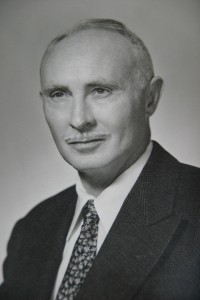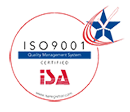Clarence B. Pool
February 8, 1909 – August 28, 2010
Accomplishments:

- While at Douglas Aircraft Company (1929 to 1939):
- Instrumental in bending aluminum skins for airplanes and fanning aluminum angles for a tube-bending machine. This resulted in the covering on airplanes being changed from fabric to aluminum. Now a new problem ensued. The rivets holding the aluminum skins on the airplane were sticking above the surface resulting in much greater resistance. This led to the need for the flush rivets.
- In 1937/38, developed flush (flathead) riveting. Clarence counter sunk the rivets, which reduced the air resistance over the aircraft’s body, enhancing fuel efficiency, speed and performance. Less static was created, helping reduce errant radio frequency waves, improving radio transmission and clarity. In short, improving the overall aerodynamics of the aircraft.
- While working for Douglas Aircraft, Clarence was “lent” to Northrop to help them out.
- In the early days of his employment with Douglas Aircraft, Clarence flew several different airplanes. He had gotten a pilot’s license before he learned to drive.
- In 1930/31, designed a fuel system for his 1929 Buick using both diesel and gas. It had two fuel tanks, two fuel filters, two carburetors and two gas pedals. Clarence made a heat exchanger that went around the manifold to atomize the diesel fuel. Once the exhaust was hot enough to vaporize the fuel, he switched from gas to diesel. The down side was the car smoked like crazy!
- In 1939 started his own business, Hydropack (later known as Cal-Tron Corporation) in Los Angeles (1939 to 1952):
- With the help of Harold Dunbar, Clarence made his own hydraulic compression molding presses. Six with clamping forces of 50 tons and three with clamping forces of 500 tons. These were known as Dunbar Presses.
- During World War II, Hydropack produced many rubber and transfer molded plastic products. They made hydraulic seals, check valves & various components that went into hydraulic systems on both commercial and military aircraft.
- In 1941/42, the leather seal on the rings Douglas Aircraft Co. made of machined aluminum, failed cold temperature tests. “We could not find a packing that would hold up and seal as it should,” Clarence said. “Everyone used a chevron packing and I developed a chevron packing that sealed permanently and stood temperatures from 120 degrees F on the tarmac down to minus 65 degrees F”. This was accomplished with a compression molded neoprene rubber retainer ring. At one time, virtually every airplane used his ring. Retainer Ring patented on December 26, 1944.
- Invented device for opening the bomb bay doors rapidly. They opened slowly due to lack of air pressure. It used to take 30 minutes for the doors to be fully opened to drop a bomb. Clarence developed a system to contain air under pressure so the doors would open quickly. Eventually this was used on all bombers during WWII. Also used in experimental bombers before WWII.
- Created plastic baby blocks with the alphabet and the numbers 1 through 10 in an era of painted wood blocks. Clarence originally compression molded sets of the blocks with urea and a small prototype tool. “I decided that was too expensive, and so I went to injection molding,” he said. He molded the blocks in polystyrene. The tool was a 12-pocket mold with 36 interchangeable cavities cast of beryllium copper. More than 1 million Cali Blox sets of 12 or 18 blocks were sold. A full set of 18 used all 36 cavities, requiring three mold changes. The tool is at Cal-Tron today and still works.
- Designed his own packaging for the Cali Blox featuring a photograph he had taken of his son, Dick, on the front.
- Built a 12 cavity tool for molding a very small nylon part. The size of mold was 2 1/2” X 2” X 1” – a truly miniature mold! This tool ran in the barn for many years. All of the kids ran it at one time or another.
- Hydropack molded, terminal blocks, indicator lights and lamp-enclosed lenses for the electronics industry. In one situation, Clarence’s design reduced the size of a square 15” terminal block to about 4 inches on all sides.
- Compression molded plates, 2 different sized bowls and a small plastic tumbler. The family has used these for years and there are still some in the cupboard today.
- In 1938/39, built a TV with Cathode Ray Tubes (CRT).
- Made improvements on metal forming presses and modified them for use with thermosetting materials.
- Had special status on commercial and military flights due to his knowledge and position within the aircraft community. Passengers would be “bumped” when Clarence needed to fly to help out one of the aircraft companies supplying planes to the war effort.
- In 1947 & ’48, Clarence designed and built an air rifle the U.S. Army was interested in for use in training servicemen. For reasons unknown, the Army did not utilize it.
- In 1949, just before the Korean War, Clarence designed an electric organ Unfortunately, once hostilities began, it was impossible to get the resistors and transistors that he needed.
- Worked on refining the sound of electric organs, making numerous fine adjustments to the action to get the optimum sound possible.
- Designed and built his own amplifiers.
- Redesigned radios for his own use, refining and improving them.
- In the late 1950’s designed a non-arching switch for use in sensitive electronic equipment. This was achieved by coating it with silicone. Static discharge is always an issue due to the damage it can cause to the electronics.
- In 1952 Hydropack became Clarence Pool Company.
- Defense contractor Litton Industries Inc. could not find anyone to build the tooling they needed. Clarence was hired to help Litton develop products that could be molded. He worked with them from the design phase to final production, even building some of the tooling.
- Instrumental in converting a glass cup, which was used in the milking of a cow, to a polycarbonate cup. The polycarbonate cup allowed a dairy farmer to see when the cow’s udder was done producing milk thus allowing the cup to be removed quickly so a cow’s udder would not be injured in a dry vacuum pull. Some initial polycarbonate processing problems with the cup prompted a visit from GE Plastics engineers. “They could not believe we were injection molding polycarbonate on a plunger molding machine,” Clarence said.
- Invented a plastic valve to go on automatic milking machines to replace the metal valve that was used then, which left metal shavings in the milk. The milk industry was very skeptical of the plastic valve, so Clarence ran two milking machines (1 with plastic and 1 with metal) 24 hours a day, 7 days a week for a year to prove the plastic would work better. The milk industry was finally convinced and converted from metal to plastic.
- In the mid 1960’s, developed the Mountain Air electrostatic precipitation air purifier. Electrostatic dust collectors use electrostatic charges to separate dust from the dusty air stream. A number of high voltage, direct current electrodes (carrying negative charge) are placed between grounded electrodes (carrying positive charge). The dust borne air stream is passed through the passage between the discharging (negative) electrodes and collecting (positive) electrodes. Dust particles receive a negative charge from the discharging electrodes (ionizing section) and are attracted to the positively charged grounded electrode (collection plates) and fasten onto it. Unfortunately, this did not take off. These types of units are now a common way to clean the air in your home.
- In the early 1960’s, developed a small piano with Harold Rhodes, which had much improved action. This eventually became the Rhodes electric piano. The original motivating factor behind this was so injured servicemen could play the piano in their hospital beds. Truly a “laptop” piano.
- Information taken from the Rhodes Corporation website: Perhaps the first great musician to recognize the instrument’s potential was the legendary jazz trumpeter Miles Davis. It was Davis, always searching for hip new sounds, who insisted his keyboardists play the Rhodes instead of the traditional piano. In doing so, the coolest man in jazz made the Rhodes the coolest keyboard instrument in the world.
- By 1967, the new sound was lighting up the airwaves. Soon, legions of jazz, rock, and pop musicians were hurrying to get the Rhodes sound into their own music. Practically every hit record of the 70’s featured a Rhodes piano. The Rhodes piano was endorsed by almost every significant keyboardist, and became the biggest selling professional electric piano of all time.
- Worked with Harold Rhodes to convert some of the wooden pieces of the electric piano to plastic. Clarence designed the parts and built some of the tooling. Cal-Tron Corporation produced 22 tools for the piano.
- In 1963, changed the name from Clarence Pool Company to Cal-Tron Corporation. His contraction for “California electronics,” with operations in Santa Fe Springs, Calif. In 1970 the business was moved to Bishop, California, with Clarence stepping down as President and his son, Dan, taking over the helm. Clarence continued to have a sales office in Pico Rivera.
- In the 1960’s, the Tagit lapidary cutting and polishing products emanated from Clarence’s longtime hobby as a rock hound. The Gy-Roc line includes Vibrahone finishing machines; the Cabber, to cut and shape an oval or convex surface and the Performer trim saw. Clarence developed the tooling. The name Tagit came from an I.D. tagging product he developed for marking cattle and the name stuck.
Held a total of 67 patents
Designed and created:
- Valve Check, patented on July 18, 1944
- Retainer Ring patented on December 26, 1944
- Shock Isolating Leg Assembly, patented on February 11, 1969.
- Cattle Tag, patented on September 23, 1969
- Light with Universally Mounted Axis For Body Panels And The Like, patented on July 25, 1972.
- Agitator for Moving Fluid Suspended Objects Through Abrasive Motions, patented on January 9, 1973.
- Cabbing Device For Gemstones, patented on May 6, 1980
Clarence passed away on Saturday, August 28, 2010, at the age of 101 ½ years.




